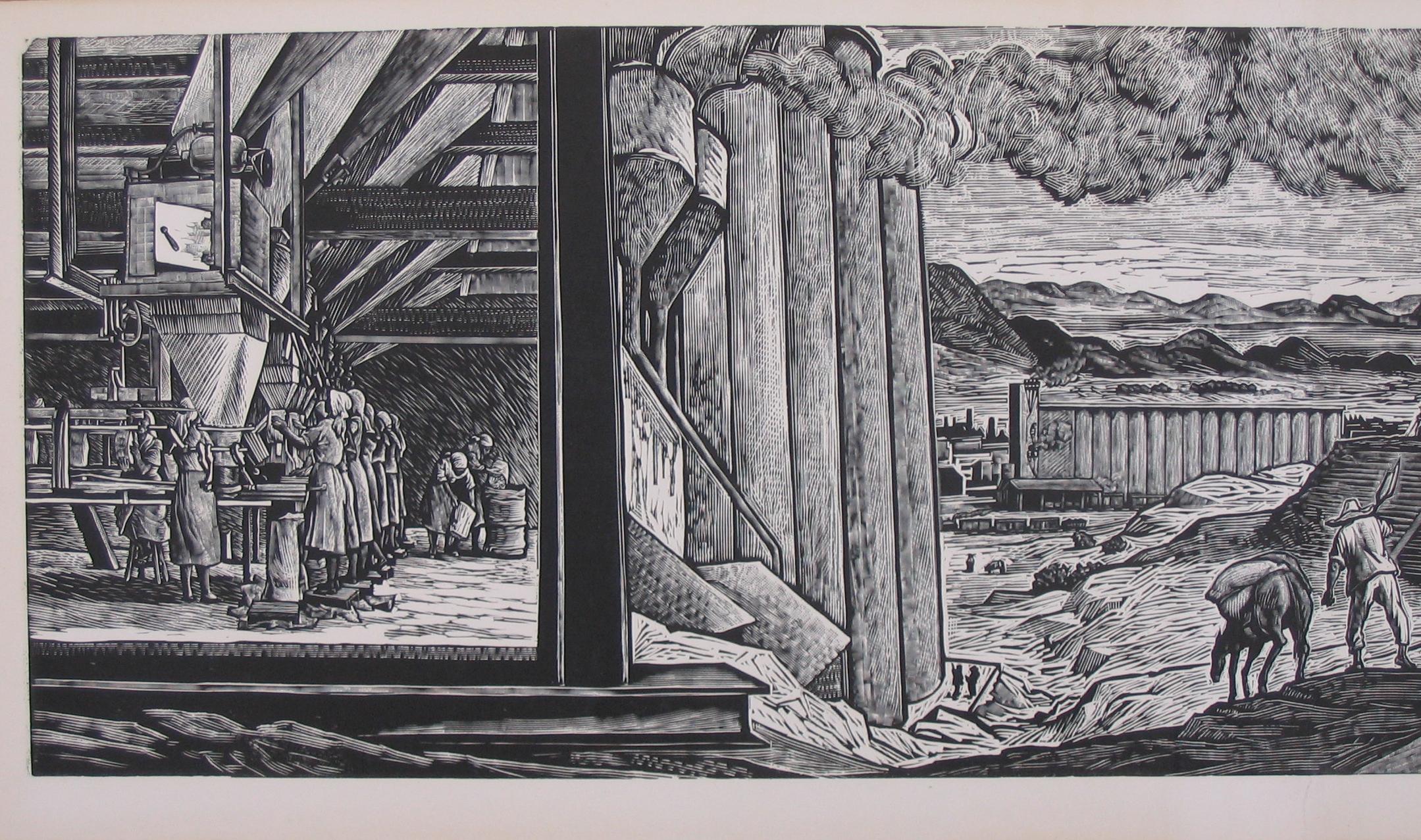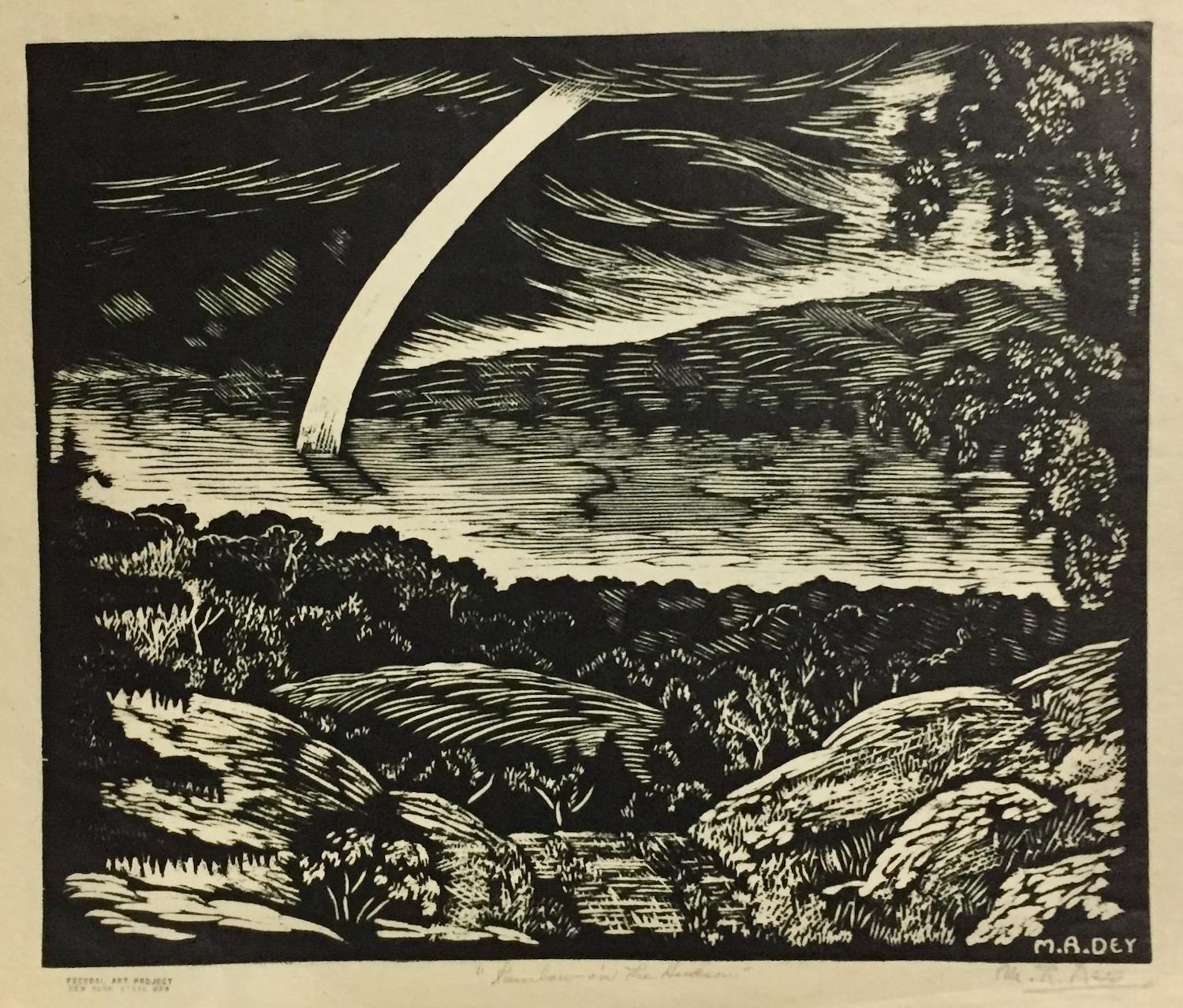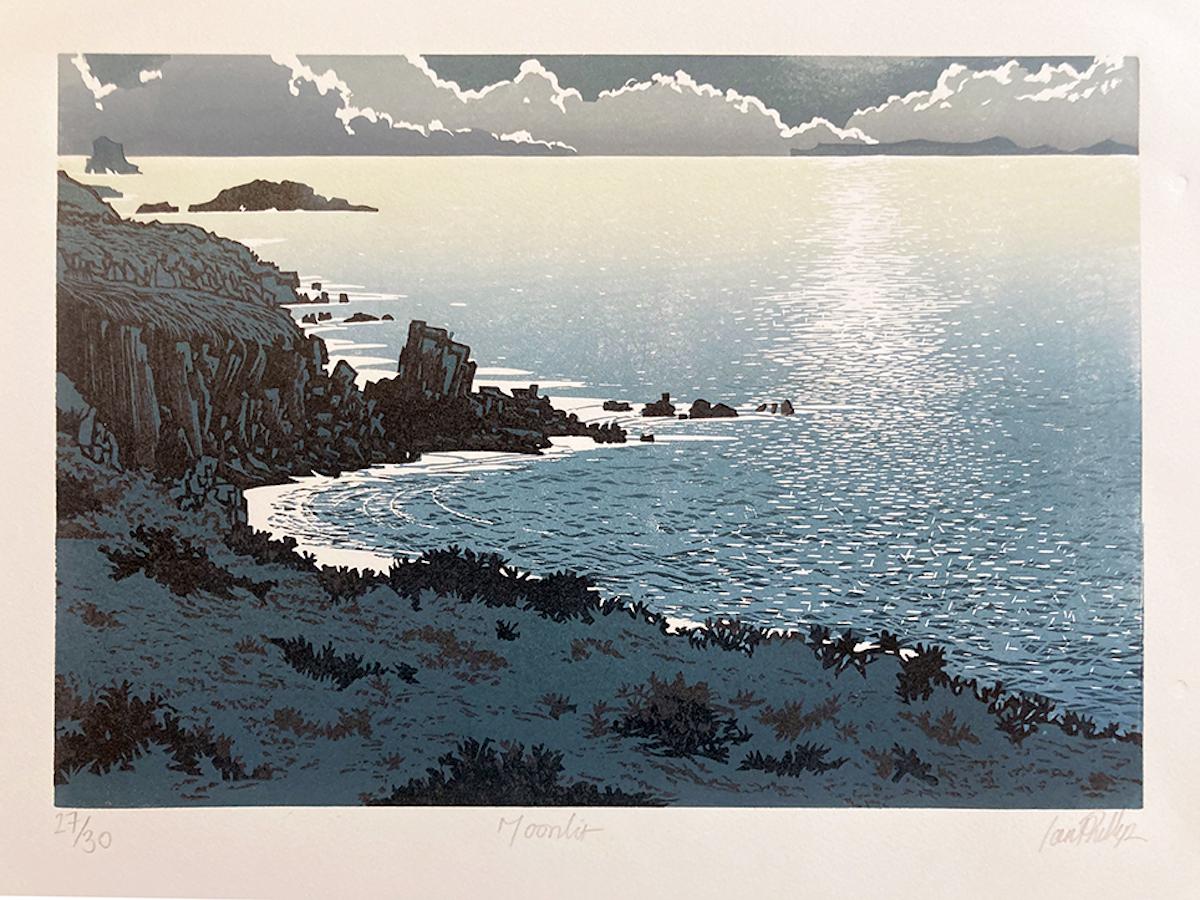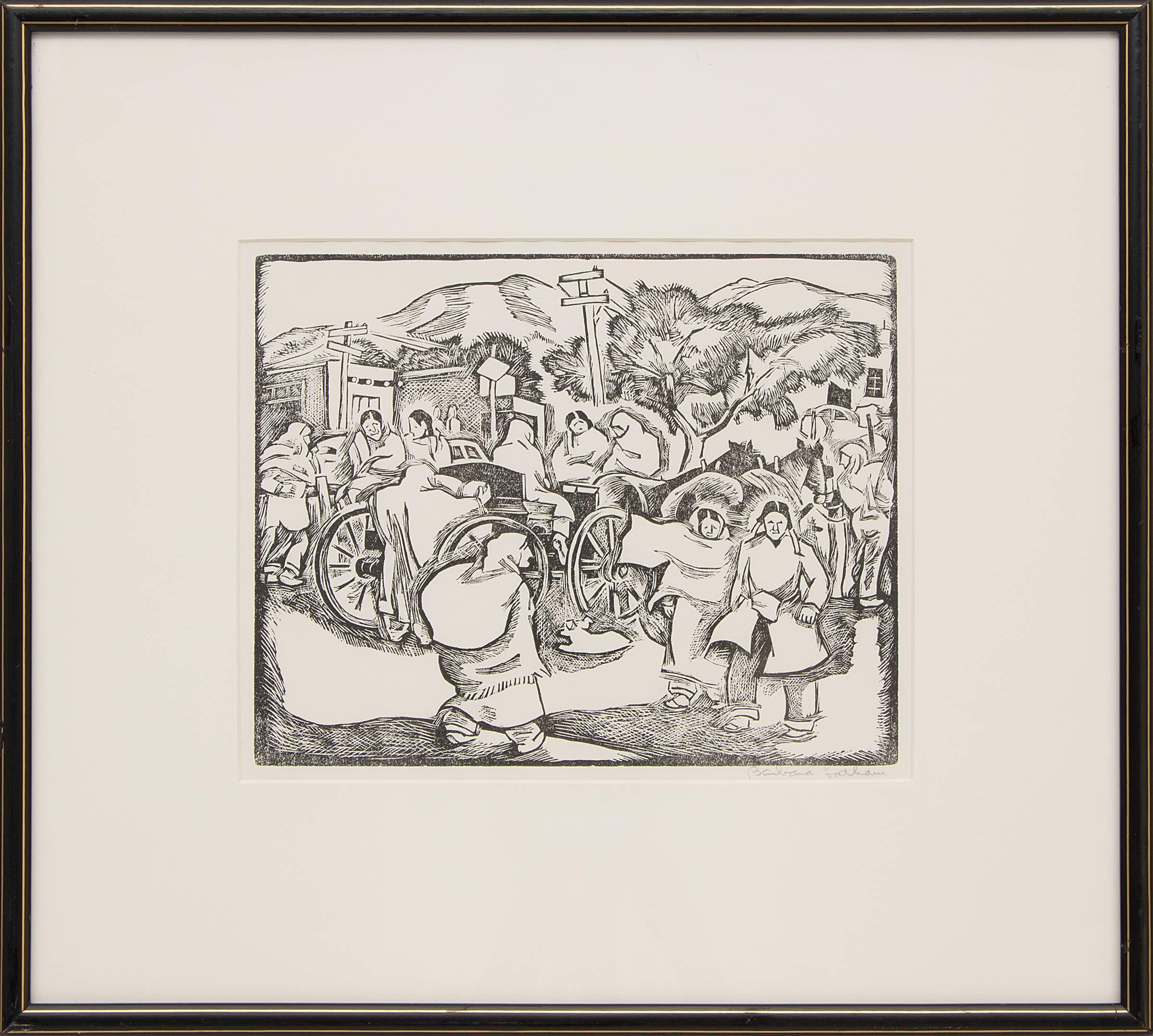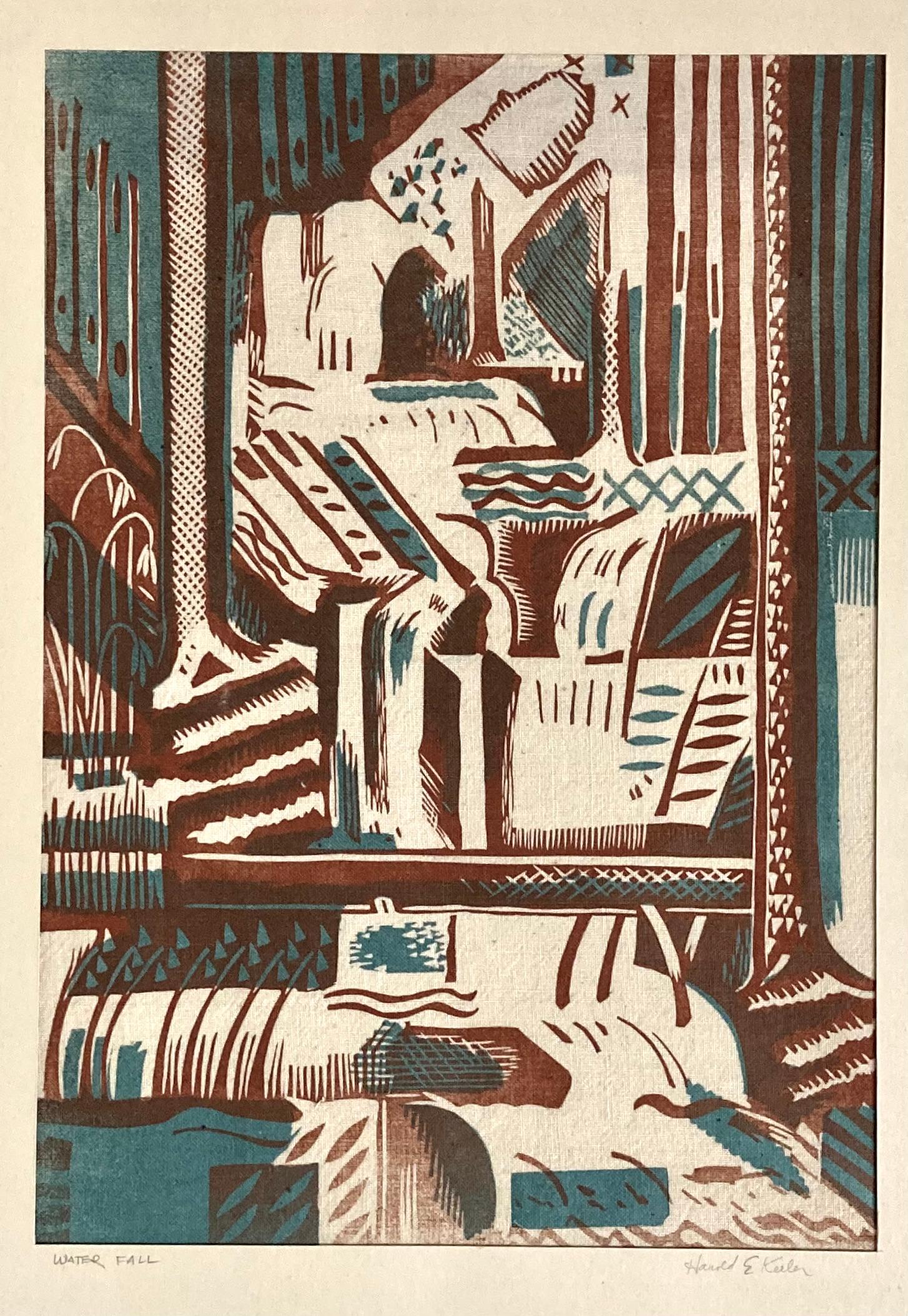Items Similar to "Kiosk in Paris" British Linocut 1/150 European Modernism Swiss Vorticism Deco
Want more images or videos?
Request additional images or videos from the seller
1 of 8
Lill Tschudi"Kiosk in Paris" British Linocut 1/150 European Modernism Swiss Vorticism Deco1933
1933
About the Item
"Kiosk in Paris" British Linocut 1/150 European Modernism Swiss Vorticism Deco
Lill Tschudi (Swiss, 1911-2004)
Kiosk in Paris (Coppel LT 29)
Linocut printed in brown black, vermilion and bluish grey, 1933, on tissue thin oriental laid paper, signed, annotated 'Handdruck' and numbered 1/50 in pencil, titled in the lower margin in pencil, Coppel notes this specific impression as one of a few colour variations within the edition. Framed by Bark.
Block 220 x 260mm (8 5/8 x 10 1/4in)
Sheet 257 x 285mm (10 1/8 x 11 1/4in)
Framed by Bark 15 x 16 1/4 inches
BIO
Lill Tschudi (1911-2001) was a prominent figure in the Grosvenor School of Modern Art* and is known primarily for her colourful and lively linocut work. Her early work explored technological advancement and the dynamism of the modern world. She later focused on sporting themes as her subjects, and after 1945 her style shifted to abstraction.
Lill Tschudi was born in the village of Schwanden, high in the mountains of eastern Switzerland. The village is known for its textile heritage, and Tschudi briefly experimented with designs for textiles when she put certain of her images onto pillow and cushion cases. She is now known almost exclusively, however, for her colour linocut work.
Tschudi was first introduced to the linocut when she saw an exhibition of the colour cuts of animals by Norbertine Bresslern-Roth (1891-1978) whilst still at school. After school she noticed an advertisement in The Studio inviting applications for a training programme specialising in linocuts at The Grosvenor School of Art, London.
Lill Tschudi attended The Grosvenor School briefly, from 1929-30, but throughout her life she maintained a close working relationship with the Grosvenor School linocut* tutor Claude Flight. He encouraged her, supporting her career and acting as a point of liaison in England whilst she worked abroad.
Her early work clearly demonstrates his influence. Flight was inspired by the concerns of the Italian Futurists* and by Vorticism*. He encouraged the depiction of a modern man-made world full of technological advancement. Tschudi explored this subject matter in her famous linocuts of motor-car racing and the London Underground.
From 1931-33, Tschudi lived in Paris and studied with the Cubist artist Andre Lhote, then with the Futurist Gino Severini at the Academie Ronson, and finally under Fernand Lger at the Academie Moderne.
Whilst in Paris she focused on the life of the city; young browsers at a news-and-print stand; bill posters; and for several of her most captivating prints, jazz music. Later on she took sporting themes as her subjects; circus tumblers, gymnasts, cyclists, runners and, like Sybil Andrews, she often depicted men at work.
Tschudi returned to Schwanden, Switzerland in 1935, but she continued to produce linocuts. Over her lifetime Tschudi produced 355 linocuts. She sent work to London regularly and received high critical acclaim. One London critic wrote: she seems to seize activity on the wing, and fix it in her linocuts.
Purchases soon followed from, amongst others, the Vand A and the British Museum. Her work is now held in major print collections around the world and was featured extensively in the (2008) exhibition British Prints from the Machine Age - Rhythms of Modern Life 1914-1939 at the Museum of Fine Arts, Boston, and the Metropolitan Museum of Art, New York.
- Creator:Lill Tschudi (1911 - 2004, English, Swiss)
- Creation Year:1933
- Dimensions:Height: 15 in (38.1 cm)Width: 17 in (43.18 cm)
- Medium:
- Movement & Style:
- Period:
- Condition:
- Gallery Location:New York, NY
- Reference Number:1stDibs: LU1156214153282
About the Seller
5.0
Platinum Seller
These expertly vetted sellers are 1stDibs' most experienced sellers and are rated highest by our customers.
Established in 2008
1stDibs seller since 2019
165 sales on 1stDibs
Typical response time: <1 hour
- ShippingRetrieving quote...Ships From: New York, NY
- Return PolicyA return for this item may be initiated within 3 days of delivery.
More From This SellerView All
- "Winch" British Linocut Grosvenor School Machine Age 1930 Woman Artist PrintBy Sybil AndrewsLocated in New York, NY"Winch" British Linocut Grosvenor School Machine Age 1930 Woman Artist Print "The Winch" 1930. 7 3/4 x 11 (sight) inches. Linocut in colors on tissue...Category
1930s Modern Figurative Prints
MaterialsLinocut
- "Rush Hour" British Modern Mid 20th Century Vorticist European Vorticism WomanBy Sybil AndrewsLocated in New York, NY"Rush Hour" British Modern Mid 20th Century Vorticist European Vorticism Woman Sybil Andrews CPE (British/Canadian, 1898-1992) "Rush Hour" (Coppel SA 11) Linocut printed in Chines...Category
1930s Modern Figurative Prints
MaterialsLinocut
- "Balcony" 1938 WPA Print Mid 20th Century American Broadway Theatre ModernismBy Leon BibelLocated in New York, NY"Balcony" 1938 WPA Print Mid 20th Century American Broadway Theatre Modernism. Silk screen on paper, 15” x 20". Numbered 15/20 lower left. Pencil si...Category
1930s American Modern Figurative Prints
MaterialsPaper, Screen
- Barbra Stresiand "Belle of 14th Street" 1973 CBS TV Special 20th Century LithoBy Albert Al HirschfeldLocated in New York, NYBarbra Stresiand "Belle of 14th Street" 1973 CBS TV Special 20th Century Litho Signed and numbered 10/150 in pencil, lower margin. Etching, 13.5” x 9.75”. Framed 21.25” x 17.25”. Pulled in 1975. Belle of 14th Street After two successful television shows on CBS, Barbra's manager, Marty Erlichman told the press, “We don't intend to go to the well once too often. The next special will have other performers. However, Barbra will never become just another hostess for just another musical variety show. Whatever we decide to do in the future shows, she will dominate in a unique fashion.” Barbra’s third television special for CBS and her sponsor, Monsanto, was titled The Belle of 14th Street . In February 1966, shortly after finishing up Color Me Barbra , Streisand and husband Elliott Gould took a second honeymoon in Paris. The trip was financed by her television corporate sponsor, Chemstrand. Barbra told the press, “I’m here to purchase the wardrobe for my next TV special. Cost is no object because my sponsor is picking up the tab.” At that point the theme of her third TV show would be fashion, and Paris offered many couture choices. Barbra was seen at a Dior fashion show wearing not the designer’s clothes, but a jaguar suit and hat she had designed herself. In all, it is said Barbra chose nine Dior outfits at a cost of $150,000. However, Barbra Streisand's third television special for CBS was postponed. In March 1966, Barbra flew to London to appear at the Prince of Wales Theatre in Funny Girl . Shortly after beginning her run in London, Barbra announced her pregnancy. Not only did that cause her concert tour to be abbreviated, but Barbra’s television special was postponed as well. Barbra told the BBC in July 1966: “I also can’t do my third television show, which I was supposed to do here [London].” Returning to the States, Barbra performed four concert dates, and then retired to enjoy the rest of her pregnancy and give birth to her son, Jason, in December 1966. CBS and Chemstrand wanted a new special by the end of 1967, therefore production on the show picked up momentum in March 1967. (Barbra was due in Hollywood in May to begin shooting the Funny Girl film.) The format and theme of the television show had changed, too. Instead of centering on fashion, Barbra’s next special would be situated in a 1900’s Vaudeville theater. “We were all determined that the show not be just a variety format,” director Joe Layton said. “We wanted something different. So we hit upon the idea of restaging a vaudeville performance. All the acts, songs, skits and specialties had to be derivative of the period between 1895-1912.” Barbra’s creative collaborators did meticulous research on Vaudeville — “We even called George Burns in Hollywood and Jack Pearl,” said Barbra’s manager, Marty Erlichman. Entitled The Belle of 14th Street , the new special would allow Barbra to play several different characters but not have to shoulder the burden of carrying another one-woman show—this time Streisand would be accompanied by guest stars: Broadway actor Jason Robards; Vaudeville veteran John Bubbles; and Lee Allen...Category
1970s Performance Figurative Prints
MaterialsLithograph
- "Cabaret" Liza Minnelli Joel Grey Broadway Film Academy Tony Award MusicalBy Albert Al HirschfeldLocated in New York, NY"Cabaret" Liza Minnelli Joel Grey Broadway Film Academy Tony Award Musical Signed and numbered 111/150 in pencil, lower margin. Etching with aquatint, 13.75” x 9.75”. Framed 22.25...Category
1970s Performance Figurative Prints
MaterialsLithograph
- "Judy Garland" Legendary Film and Recording Star. Gay Icon. 20th Century LithoBy Albert Al HirschfeldLocated in New York, NY"Judy Garland" Legendary Film and Recording Star. Gay Icon. 20th Century Litho Judy - All Star Variety - Garland. Signed and numbered 19/150 in pencil, lower margin. Etching and aqu...Category
1970s Performance Figurative Prints
MaterialsLithograph
You May Also Like
- THE MAKING OF TORTILLAS - Mural Size 47 1/2 inches LongBy Leopoldo MéndezLocated in Santa Monica, CALEOPOLDO MENDEZ (1902 – 1969) THE MAKING OF TORTILLAS 1954 Linocut. Edition unknown. This example signed in pencil and dated 1957. 14” x 47 3/8” ...Category
1950s Modern Figurative Prints
MaterialsLinocut
- Maurice Robert Dey, Rainbow on the HudsonLocated in New York, NYBiographical information on Maurice Robert Dey is hard to find. He was born on 1899 (or maybe 1900), in Switzerland. As an adult he lived and worked in Woodstock, the NY artists' c...Category
1930s American Modern Landscape Prints
MaterialsLinocut
- VILLAGE SCENE / TOWN FESTIVALBy Herbert GurschnerLocated in Santa Monica, CAHERBERT GURSCHNER (Austrian / English (1901-1975) VILLAGE SCENE / TOWN FESTIVAL ca.1924 Color woodcut 4 ¾ x 5 3/8” Signed in pencil. Good strong colors. On thin paper. Faint darkeni...Category
1920s Modern Figurative Prints
MaterialsWoodcut, Linocut
- Moonlit, Ian Phillips, Contemporary art, Limited edition Lino print, Sea ArtLocated in Deddington, GBMoonlit by Ian Phillips [2022] limited_edition and hadn't signed by the artist Linocut Edition number 19/30 Image size: H:41 cm x W:28.5 cm Complete Size ...Category
21st Century and Contemporary Modern Landscape Prints
MaterialsPaper, Linocut
- Saturday Morning (Market, Taos Plaza, New Mexico), 1950s Figural Linocut PrintBy Barbara LathamLocated in Denver, CO1950s modernist linoleum cut print titled 'Saturday Morning (Market, Taos Plaza, New Mexico) by New Mexican artist Barbara Latham. Depicting a busy Saturday morning at the market in Taos Pueblo with horse and cart, Native American figures, adobe buildings and mountains in the background. Presented in a custom frame with all archival materials, outer dimensions measure 16 x 17 ¾ inches. Image size is 8 ½ x 10 ½ inches. About the Artist: Beginning her career as a commercial artist, Barbara Latham travelled to Taos in 1925 seeking material for a greeting card. Serendipitously, she also found her life partner, Howard Cook, who was similarly looking for ideas for illustrations. Perhaps both were fueled in their quest by the tales of their mutual teacher, Andrew Dasburg, who knew of the energy and stimulation of this artist community. Observing local people and customs, Latham created genre scenes that offer a window into this now-vanished time and place. Her lively illustrations for numerous children's books are a significant contribution to that graphic art in the mid-20th century. Born in Walpole, Massachusetts, Latham's student days included Norwich Art School and Pratt Institute in Brooklyn; but it was contact with the charismatic Dasburg at the Art Students League in Woodstock that opened her world and her view of art. Getting work with companies like Norcross Publishing and Forum magazine, she eventually made her way to Taos. Among all the spirited young artists gathered there, she met Howard Cook, who was designing illustrations for Willa Cather's Death Comes to the Archbishop. The two married in Santa Fe and began a nomadic life together. The young couple made their way to Paris, a likely destination for modernist artists. Upon receiving a Guggenheim to study fresco painting in 1932, Cook, along with Latham, took an alternative direction and headed to Taxco, Mexico. At this time, Mexican muralists, such as Diego Rivera, were capturing the attention of progressive artists. During the Depression, both Cook and Latham aligned themselves with a populist ideal. Latham contributed work, such as "Fording the Stream" and "Bear Family," to the American Artists Group, which was founded to produce original prints at affordable prices. The couple also travelled in the Deep South to the Ozarks and to "Alabama's Black Belt." When Latham settled in Taos, she was committed to an art of and for the people. Rather than a romanticized re-creation, her choice of subjects was based in common everyday activities, favoring those which brought people together. Taos Pueblo was an ancient, indigenous community, and Latham's view extended that tradition into a contemporary, multi-ethnic village. Sharing some of the spirit of WPA photographs...Category
Mid-20th Century American Modern Figurative Prints
MaterialsLinocut
- Harold E. Keeler, Water FallLocated in New York, NYHarold E. Keeler worked in Hollywood as a set designer. That seems especially important here because the Water Fall looks a little as though it could be a woodland stage set -- to me...Category
1930s American Modern Landscape Prints
MaterialsLinocut
Recently Viewed
View AllMore Ways To Browse
Swiss Design Poster
Studio 1 11
Swiss 30 Made
Vintage New England Poster
British Art Deco
Art Deco Modernism
Early European Modernism
Used Swiss Machines
Cubist Music
Italian Poster Animal
Motor Posters
Jazz Man
Art Deco Advertisement
Art Deco Winged
Vintage Car Racing
1891 Poster
Art Deco Flight
Vintage Machine Stand
